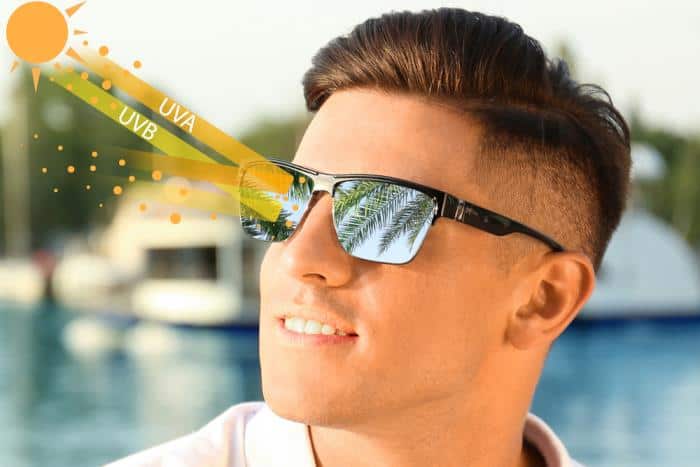If you’ve ever found yourself squinting behind the wheel on a sunny day, you’ve probably wondered: “What color sunglass lens is best for driving?”
With an array of lens colors and tints on the market, it can be hard to figure out which one truly enhances your driving experience.
Today, we’re going to break down the facts, cutting through the marketing noise to help you make an informed decision.
(This page contains affiliate links. OGR may receive compensation if you click a link and make a purchase.)
Gray and Black Lenses

When you’re cruising down the highway with the sun in your face, sunglasses with gray or black lenses are usually best.
Why? Because these lenses provide the darkest tint, reducing eye strain in bright light.
Gray and black maintain natural color perception, reduce distortion, and keep things as true-to-life as your eyes would naturally see them.
Here are a couple of great shades with gray/black lenses:
Can’t get any better than a pair of Ray-Ban Aviators, which have a ton of style but also great functionality. Perfect for long drives under the sun!
The original B15 black lens color allows 15% visible light transmission (VLT), meaning it filters out 85% of light. It’s best for bright conditions, giving you clear, comfortable vision and protection.
If you have sensitive eyes, Ray-Ban’s gray-green G15 lens is especially useful for reducing glare. It also works well under variable light conditions.
Oakley’s Holbrook with Black PRIZM lenses provides excellent glare reduction and enhances contrast, giving you excellent visual clarity for safe driving.
Oakley’s PRIZM lens technology boosts certain color wavelengths, so instead of just darkening your overall vision, it actually helps you see better.
Bronze and Amber Lenses

Now that you know what lens colors are best for bright, sunny days, you might be wondering what’s best for overcast conditions.
For cloudy days, or low light like dusk and dawn, bronze and amber lenses are the best choice as they help improve contrast and increase depth-perception.
Bronze and amber are warm colors that can enhance contrast, particularly reds and yellows, helping you better see traffic signals and road signs when there’s less ambient light.
A couple of good options are:
This pair from Blenders Eyewear is a classic Wayfarer-style frame that’s lightweight and comfortable to wear all day long.
The PureBlend amber lens is especially great right after sunrise and just before sundown, when you see the world in a softer light.
Maui Jim’s Peahi with HCL Bronze lenses are a fantastic choice for drivers. The 8-base wraparound frame provides excellent peripheral vision, and is well-suited for larger heads.
Maui Jim’s famous glass lenses provide exceptionally crisp, clear visuals, allowing you to see details that are often obscured with other lenses.
The HCL stands for “High Contrast Lens”, which, as the name suggests, help you perceive contrasts much better, especially in variable and lower light conditions.
They’re polarized to reduce glare, and have anti-reflective coating on the back of the lens so you don’t get any reflection of light when rays hit the inside of your lenses.
Tints To Avoid
Now that we’ve gone over the best sunglass tints for driving, which colors should you avoid? While green, blue, red, or pink lenses might make for a fun fashion statement, they aren’t the most practical for driving.
Why? Well, these hues can distort colors or reduce contrast, potentially impairing your ability to see traffic lights, brake lights, road signs, and other important information on the road.
Other Important Lens Treatments
UV Protection

Let’s not forget about the all-important UV protection. You might assume that all sunglasses already have UV-protection, but that’s not always the case.
Most high-quality sunglasses offer 100% UVA/UVB protection – it should be labeled as such when you go to purchase a pair. If it doesn’t, look for a pair that does.
UV-blocking is not tied to the color of the lens, so you can have it in any lens color. Be it amber, gray, or black; you should ensure that your sunglasses protect your eyes from harmful UV rays.
Polarized Lenses

Polarized lenses have a superpower – they significantly reduce glare by blocking horizontal light waves.
This is particularly beneficial while driving because blinding glare often reflects off bodies of water, shiny surfaces, or other cars.
By reducing glare, polarized lenses can significantly increase your visual comfort and lessen eye fatigue.
However, there’s one thing to be aware of – polarized lenses might make reading your dashboard screen or smartphone more difficult.
Also, some drivers report difficulties seeing through car windows with certain types of window tint or heating elements when wearing polarized lenses.
Anti-Reflective Coating

An important lens treatment you should always prioritize getting is anti-reflective coating. This addition is not just important—it’s pivotal for any pair of glasses, whether they’re optical or sun.
Anti-reflective coating works by reducing reflections off the surfaces of your lenses. It improves your vision, decreases eye strain, and generally make your glasses look more attractive.
When light isn’t being reflected off your lenses, more of it passes through to your eyes, improving clarity and contrast.
This is particularly helpful while driving, especially at night when glare from oncoming vehicles can be a nuisance.
Here’s an insider tip: not all anti-reflective coatings are created equal. The effectiveness of this coating can vary based on its quality.
A good anti-reflective coating will be more durable, easier to clean, and more resistant to scratches. So, it’s not just about having an anti-reflective coating, but about having a quality one.
Night Driving Lenses

When it comes to night driving, wearing sunglasses isn’t advisable as it can make it harder to see in low-light conditions.
You might have heard that yellow-tinted lenses are good for night driving. While yellow lenses can improve contrast in some conditions, the benefits are often outweighed by the drawbacks of reduced overall light transmission.
If you need prescription glasses for night driving, the best option is clear lenses with an anti-reflective coating. They can improve your vision and comfort, making your night-time drives safer.
Individual Differences
Finally, it’s important to remember that we’re all different. What works well for one person may not work as well for another.
Some people might find certain tints more comfortable than others. Our perception of color can also differ.
So, when choosing driving sunglasses, it’s crucial to take your individual preferences and comfort into account.
Other Options
Besides tint, there are a couple more lens treatments that can help enhance your overall driving experience:
Mirrored Lenses

Looking for a cool look with functional benefits? Mirrored lenses have a reflective coating on the outer surface that reflects light away.
(They also obscure your eyes from others if that’s your thing.)
Mirrored lenses help reduce glare, which can be a lifesaver, especially on super sunny days.
Gradient Lenses
Gradient lenses are darker at the top and gradually become less tinted towards the bottom. This makes reading your dashboard easier, as the lower part of the lens allows more light through.
However, while gradient lenses are handy for checking your speed or changing the radio station, they might not provide enough darkness when looking at the road or traffic ahead, especially in bright light conditions.
Bottom Line
Good vision while you’re on the road is paramount, so getting the right shades for driving aren’t just about looking cool on your wheels. They’re about safety, clarity, and comfort.
Whether you’re navigating the sun’s glare or adjusting to overcast conditions, the right tint can make all the difference.



